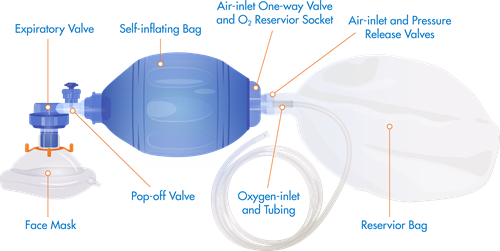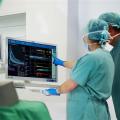Real BVM Help
Patients suffering from respiratory failure, traumatic injuries, or cardiac arrest may display signs of inadequate respiration or apnea, indicating a need for oxygen and ventilatory support. In the prehospital environment rescuers turn to a basic but vital piece of equipment, the bag valve mask (BVM), to support these patients. They use a BVM to provide manual ventilation, stabilizing a patient and giving rescuers time to treat medical issues requiring immediate attention.
Although a basic tool, the BVM requires skill and practice for even the most seasoned rescuers to use successfully. Studies show that despite training and regular recertification in Basic Life Support (BLS) CPR, it's difficult for rescuers to provide BVM ventilations at the recommended breaths per minute, potentially causing significant health challenges for patients.1
The Components of a BVM
A BVM is comprised of a nonrebreathing valve situated between a facemask and a self-inflating bag; a reservoir bag is attached to the end of the self-inflating bag and there is a connection for an oxygen source. BVMs are used to manually ventilate a patient and can be used with other advanced airway adjuncts such as endotracheal tubes, supraglottic airways, and tracheostomy tubes.

How to Manually Ventilate With a BVM
To perform BVM ventilation, also referred to as manual ventilation, the flexible mask is placed over the patient's mouth and nose in a way that ensures a tight seal. The “C-E” grip is one way to do this: the middle, ring, and little fingers (the “E”) are placed under the jaw while the thumb and index finger (the “C”) press down on the mask. When possible, two rescuers deliver manual ventilations so that one can focus on a tight seal while the other focuses on squeezing the self-inflating bag steadily and smoothly. Doing so pushes air into the patient’s nose and mouth. The 2020 American Heart Association Guidelines recommends manually ventilating an adult patient at a rate of 10 breaths per minute until spontaneous breathing returns or advanced cardiac lifesupport (ACLS) measures are taken.2
Overcoming Manual Ventilation Challenges
Real BVM Help® from ZOLL® addresses rescuers’ need for real-time feedback in the field.
With Real BVM Help, a sensor and cable connected to the Propaq® M/MD monitor/defibrillator is connected in line to the BVM. During manual ventilations, the sensor — using new technology from ZOLL — collects ventilation data and displays it in real time on the Propaq M/MD monitor. A Ventilation Quality Indicator (VQI) ring fills for each breath, changing color based on ventilation quality, volume, and rate — green when in target and yellow when out of target. A glance at the Real BVM Help display on the Propaq M/MD monitor tells clinicians how well their patient is being ventilated and how to make adjustments to improve ventilation quality.
ZOLL is the only company that offers a monitor/defibrillator that provides real-time feedback ventilation rate and volume on its display. Regardless of the conditions in the field or a patient’s other medical challenges, with Real BVM Help on Propaq M/MD, clinicians can improve the quality of manual ventilation in the field and can adjust instantly to meet a patient’s changing needs.
1Aufderheide TP, Lurie KG. Crit Care Med. 2004 Sep;32(9 Suppl):S345–51.
2Panchal AR, et al. Circulation. 2020;142:S366–S468.
3Bucher JT, et al. Bag Mask Ventilation. StatPearls, https://www.ncbi.nlm.nih.gov/books/NBK441924/. Treasure Island (FL): StatPearls Publishing; 2021. Accessed 25 May 2021.














